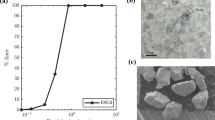Abstract
This paper shows that pressure drop-flow rate performance of an electrorheological (ER) fluid flowing through a packed bed of glass beads is consistent with a modified Ergun equation for yield stress flow through a packed bed. ER fluids are of scientific and engineering interest due to the sensitivity of their rheological properties on the applied electric field. As far as we know ER fluids have not been studied for flows through porous media. In this work a silica particle–silicone oil suspension is pumped through a rectangular packed bed of glass beads with applied electric fields. The silica particles are observed to form fibrous structures parallel to the electric field that stretch between the beads and extend between the electrodes. The pressure drop-flow rate performance agrees well with the expected performance calculated from a modified Ergun equation for a yield stress fluid flow through the packed bed with the viscosity and yield stress as functions of the applied electric field.
Similar content being viewed by others
Abbreviations
- d p :
-
Bead diameter (m)
- f :
-
Friction factor
- h :
-
Channel height (m)
- H ep :
-
Hedstrom number for packed bed flow
- L :
-
Bed or channel length between pressure taps (m)
- ΔP :
-
Pressure drop (kPa)
- Q :
-
Volumetric flow rate (m3/s)
- R ep :
-
Reynolds number for packed bed flow
- V :
-
Empty bed average velocity (m/s)
- v z :
-
Local velocity in the z-direction (m/s)
- W :
-
Width of channel (m)
- ɛ:
-
Packed bed porosity
- \(\dot{\gamma}\) :
-
Strain rate (s−1)
- μ 0 :
-
Viscosity of yield stress fluid (kg/m s)
- ρ :
-
Fluid density (kg/m3)
- τ 0 :
-
Yield stress (N/m2)
- τw :
-
Shear stress at the channel wall (N/m2)
- τ xz :
-
Local shear stress (N/m2)
References
Al-Fariss T.F. (1989). A new correlation for non-Newtonian flow through porous media. Comput. Chem. Eng. 13: 475–482
Balhoff M.T. and Thompson K.E. (2004). Modeling the steady flow of yield-stress fluids in packed beds. AIChE J. 50: 3034–3048
Bird R.B., Stewart W.E. and Lightfoot E.N. (1960). Transport Phenomena. Wiley, New York
Chase G.G. and Dachavijit P. (2005). A correlation for yield stress fluid flow through packed beds. Rheol. Acta 44: 495–501
Chen M., Rossen W. and Yortsos Y.C. (2005). The flow and displacement in porous media of fluids with yield stress. Chem. Eng. Sci. 60: 4183–4202
Conrad H. (1993). Structure and mechanisms of electro-rheological (ER) fluids. In: Roco, M.C. (eds) Particulate Two-Phase Flow, pp 355–390. Butterworth, Boston
Deen W.M. (1998). Analysis of Transport Phenomena. Oxford University Press, Oxford
Filisko F.E. (1995). Overview of ER Technology. In: Havelka, K.O. and Filisko, F.E. (eds) Progress in Electrorheology, pp 3–18. Plenum, New York
Foust, A.S., Wenzel, L.A., Clump, C.W., Maus, L., Andersen, L.B. Principles of Unit Operations. Wiley, New York, pp. 537–539 (1960)
Gamota D.R. and Filisko F.E. (1991). Dynamic mechanical studies of electrorheological materials: moderate frequency. J. Rheol. 35: 399–425
Gorodkin, R.G., Blokh, G.M., Bukovich, I.V., Demidenko, T.A.: Flow of electrorheological suspensions in channels of different geometry. Elektroreol. Issled. i Pril. Minsk, 52–65 (1981)
Halsey T.C. (1992). Electrorheological fluids. Science 258: 761–766
Havelka K.O. (1995). Novel materials for electrorheological fluids. In: Havelka, K.O. and Filisko, F.E. (eds) Progress in Electrorheology, pp 43–54. Plenum, New York
Korobko E.V., Gorodkin R.G., Mardosevich M.I., Mardosevich E.I. and Korobko A.O. (2005). Peculiarities of showing capillary effects by electrorheological fluids. Int. J. Mod. Phys. B Condens. Matter Phys. Stat. Phys. Appl. Phys. 19: 1388–1394
Korobko E.V., Gorodkin R.G., Melnichenko V.V. and Zhou L.W. (1996). Boundary effects at ERF spreading in electric field. Int. J. Mod. Phys. B 10: 3357–3365
Korobko E.V., Ragotner M.M., Gorodkin R.G. and Bukovich I.V. (1991). Electrorheological fluid as an element in clutches. J. Intelligent Mater. Syst. Struct. 2: 215–227
Macosko C.W. (1994). Rheology Principles, Measurements and Applications. Wiley, New York
Patel, A.R., Chase, G.G.: Control of fiber orientation in non-woven media by electric field. In: 9th World Filtration Congress, New Orleans, American Filtration Society, April 2004, pp. 151–169
Pialet J.W. and Clark D.R. (1995). The dependence of shear stress and current density on temperature and field for model electrorheological fluids. In: Havelka, K.O. and Filisko, F.E. (eds) Progress in Electrorheology, pp 251–262. Plenum, New York
Shul’man Z.P., Deinega Yu.F., Gorodkin R.G. and Matsepuro A.D. (1971). Electrorheology. Prog. Heat Mass Transfer 4: 109–125
Stipanovic A.J. and Schoonmaker J.P. (1995). The impact of crystalline phase morphology on the water promoted electrorheological effect of polysaccharides. In: Havelka, K.O. and Filisko, F.E. (eds) Progress in Electrorheology, pp 195–205. Plenum, New York
Vacassy R., Flatt R.J., Hofmann H., Choi K.S. and Singh R.K. (2000). Synthesis of microporous silica spheres. J. Colloid Interface Sci. 277: 302–315
Wales J.L.S., Den Otter J.L. and Janeshitz-Kriegl H. (1965). Comparison between slit viscometry and cylindrical capillary viscometry of polyethylene melts. Rheol. Acta 4: 146–152
Wu Y.-S. and Pruess K. (1996). Flow of non-Newtonian fluids in porous media. Adv. Porous Media 3: 87–184
Author information
Authors and Affiliations
Corresponding author
Rights and permissions
About this article
Cite this article
Chase, G.G., Dachavijit, P. An experimental study of electrorheological fluid flow through a packed bed of glass beads. Transp Porous Med 72, 25–35 (2008). https://doi.org/10.1007/s11242-007-9133-4
Received:
Accepted:
Published:
Issue Date:
DOI: https://doi.org/10.1007/s11242-007-9133-4




